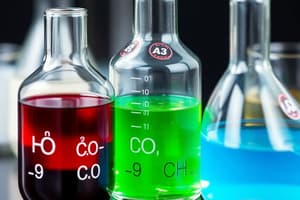Podcast
Questions and Answers
What is the general reaction for an acid-base reaction?
What is the general reaction for an acid-base reaction?
- Base + Water → Hydroxide ion + Cation
- Acid + Base → Hydrogen ion + Hydroxide ion
- Acid + Base → Salt + Water
- Acid + Water → Hydrogen ion + Anion (correct)
What is the pH range for acidic solutions?
What is the pH range for acidic solutions?
- pH 0 to 7 (correct)
- pH 3 to 11
- pH 5 to 9
- pH 7 to 14
Which of the following is a characteristic of a basic (alkaline) solution?
Which of the following is a characteristic of a basic (alkaline) solution?
- Has a pH value less than 7
- Turns litmus paper red
- Contains a high concentration of hydrogen ions
- Contains a high concentration of hydroxide ions (correct)
What is the purpose of using acid-base indicators?
What is the purpose of using acid-base indicators?
How does the presence of other substances affect acid-base equilibria?
How does the presence of other substances affect acid-base equilibria?
Which type of acids release hydrogen ions (H+) when dissolved in water?
Which type of acids release hydrogen ions (H+) when dissolved in water?
What type of bases produce hydroxide ions (OH-) or hydrogen ions (H+) when ionized in water?
What type of bases produce hydroxide ions (OH-) or hydrogen ions (H+) when ionized in water?
Which acid-base theory involves the donation of a proton (H+) to another compound?
Which acid-base theory involves the donation of a proton (H+) to another compound?
What do Lewis Bases provide to form a coordinate covalent bond with Lewis Acids?
What do Lewis Bases provide to form a coordinate covalent bond with Lewis Acids?
Which scale is used to measure the acidity or basicity of a substance?
Which scale is used to measure the acidity or basicity of a substance?
Study Notes
Acid and Base Chemistry: Understanding Properties, Reactions, Indicators[^1][^6]
Acids and bases play essential roles in numerous chemical processes, from our daily life to industrial applications. They have different properties and react with other compounds following distinct rules. In this article, we will delve into the basics of these substances, exploring their characteristics, the pH scale, acid-base reactions, base properties, and acid-base indicators[^1][^5].
Properties of Acids[^2][^5]:
- Arrhenius Acids: These acids release hydrogen ions (H+) when dissolved in water. Examples include HCl, HNO3, H2SO4, and HBr.
- Bronsted-Lowry Acids: These acids donate a proton (H+) to another compound. Examples include CH3COOH (acetic acid), HF, and H2O (water).
- Lewis Acids: These acids accept a pair of electrons from a Lewis Base. Examples include BF3, AlCl3, and FeCl3.
Properties of Bases[^2][^5]:
- Arrhenius Bases: These bases consist of compounds that ionize in water and produce hydroxide ions (OH-) or hydrogen ions (H+). Some examples are NaOH, Ca(OH)2, and Ba(OH)2.
- Bronsted-Lowry Bases: These bases accept a positive hydrogen ion (H+) from another compound in a reaction called proton transfer. Examples include NH3, CH3NH2, and R2NH.
- Lewis Bases: These bases provide a pair of electrons to a Lewis Acid, forming a coordinate covalent bond. Examples include Cl-, Br-, and SO2.
Acid-Base Reactions[^2][^5]: Acid-base reactions involve the transfer of hydrogen ions between two compounds. These reactions can occur either in water or in a solvent like ethanol. The general reaction is:
Acid + Water → Hydrogen ion + Anion Base + Water → Hydroxide ion + Cation
pH Scale[^3]: The pH scale measures the acidity or basicity of a solution, ranging from 0 to 14. A pH value below 7 indicates acidity (acidic), while a pH above 7 indicates basicity (alkaline). Pure water has a pH of 7, which is considered neutral.
Acid-Base Equilibria[^3]: In chemistry, acid-base equilibria refer to the balance between acidic and basic compounds in a solution. These equilibria can shift depending on various factors, such as temperature or the presence of other substances[^4].
Acid-Base Indicators[^4]: Acid-base indicators are chemical compounds that change color in response to changes in pH levels. They are often used to determine whether a solution is acidic, basic, or neutral. Some common examples include litmus paper and phenolphthalein. These indicators function by undergoing a proton transfer reaction with the solution's hydrogen ion concentration, resulting in changes to their color or other properties.
In conclusion, understanding chemistry of acids and bases involves delving into various subtopics such as properties, acid-base reactions, pH scale, base properties, and acid-base indicators. By examining these areas, we can gain insights into the fundamental behavior of acids and bases and their role in diverse scientific applications.
Studying That Suits You
Use AI to generate personalized quizzes and flashcards to suit your learning preferences.
Description
Explore the fundamental concepts of acids and bases, including their properties, acid-base reactions, the pH scale, base properties, and acid-base indicators. Delve into topics such as Arrhenius, Bronsted-Lowry, and Lewis acids and bases, as well as the significance of acid-base equilibria in chemical systems.



